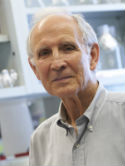Point mutation in Kit receptor tyrosine kinase reveals essential roles for Kit signaling in spermatogenesis and oogenesis without affecting other Kit responses Journal Article
| Authors: | Kissel, H.; Timokhina, I.; Hardy, M. P.; Rothschild, G.; Tajima, Y.; Soares, V.; Angeles, M.; Whitlow, S. R.; Manova, K.; Besmer, P. |
| Article Title: | Point mutation in Kit receptor tyrosine kinase reveals essential roles for Kit signaling in spermatogenesis and oogenesis without affecting other Kit responses |
| Abstract: | The Kit receptor tyrosine kinase functions in hematopoiesis, melanogenesis and gametogenesis. Kit receptor-mediated cellular responses include proliferation, survival, adhesion, secretion and differentiation. In mast cells, Kit-mediated recruitment and activation of phosphatidylinositol 3'-kinase (PI 3-kinase) produces phosphatidylinositol 3'-phosphates, plays a critical role in mediating cell adhesion and secretion and has contributory roles in mediating cell survival and proliferation. To investigate the consequences in vivo of blocking Kit-mediated PI 3-kinase activation we have mutated the binding site for the p85 subunit of PI 3-kinase in the Kit gene, using a knock-in strategy. Mutant mice have no pigment deficiency or impairment of steady-state hematopoiesis, However, gametogenesis is affected in several,ways and tissue mast cell numbers are affected differentially. While primordial germ cells during embryonic development are not affected, Kit(Y719F)/Kit(Y719F) males are sterile due to a block at the premeiotic stages in spermatogenesis. Furthermore, adult males develop Leydig cell hyperplasia. The Leydig cell hyperplasia implies a role for Kit in Leydig cell differentiation and/or steroidogenesis. In mutant females follicle development is impaired at the cuboidal stages resulting in reduced fertility. Also, adult mutant females develop ovarian cysts and ovarian tubular hyperplasia. Therefore, a block in Kit receptor-mediated PI 3-kinase Signaling may be compensated for in hematopoiesis, melanogenesis and primordial germ cell development, but is critical in spermatogenesis and oogenesis. |
| Keywords: | signal transduction; controlled study; nonhuman; mutant protein; animal cell; mouse; meiosis; mouse mutant; animals; mice; animal tissue; cells, cultured; proto-oncogene proteins c-kit; melanocytes; animal experiment; enzyme activation; protein tyrosine kinase; phosphorylation; phosphatidylinositol 3 kinase; infertility; leydig cell; animalia; pigmentation; mice, inbred strains; germ cells; hyperplasia; 1-phosphatidylinositol 3-kinase; binding site; cell count; hematopoiesis; point mutation; ovarian follicle; cell hyperplasia; oocyte development; spermatogenesis; mast cell; mast cells; oogenesis; ovary follicle development; kit receptor tyrosine kinase; male; female; priority journal; article; pi 3-kinase; leydig cells |
| Journal Title: | EMBO Journal |
| Volume: | 19 |
| Issue: | 6 |
| ISSN: | 0261-4189 |
| Publisher: | Wiley Blackwell |
| Date Published: | 2000-03-15 |
| Start Page: | 1312 |
| End Page: | 1326 |
| Language: | English |
| PUBMED: | 10716931 |
| PROVIDER: | scopus |
| PMCID: | PMC305672 |
| DOI: | 10.1093/emboj/19.6.1312 |
| DOI/URL: | |
| Notes: | Export Date: 18 November 2015 -- Source: Scopus |
Altmetric
Citation Impact
BMJ Impact Analytics
MSK Authors
Related MSK Work







